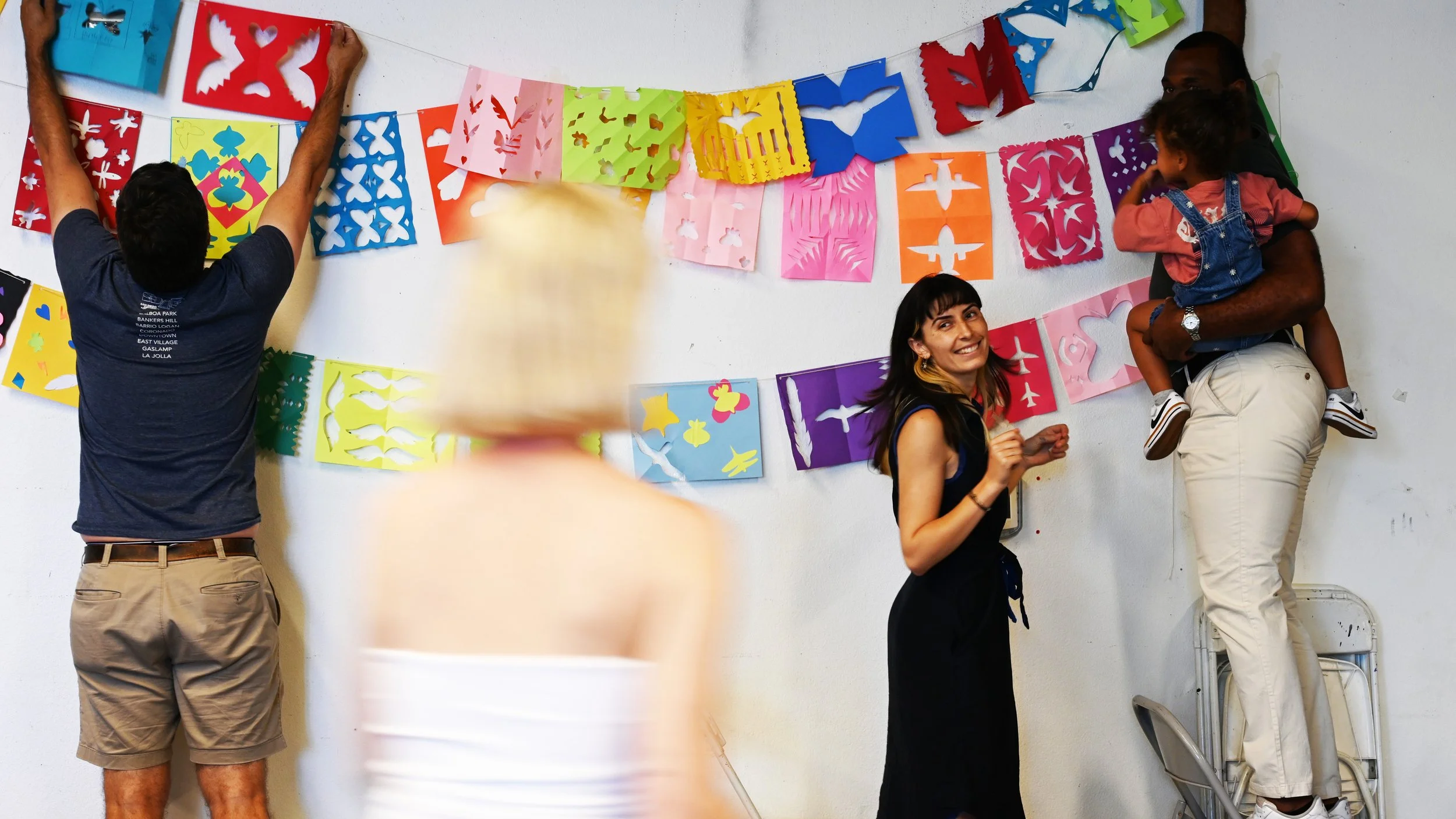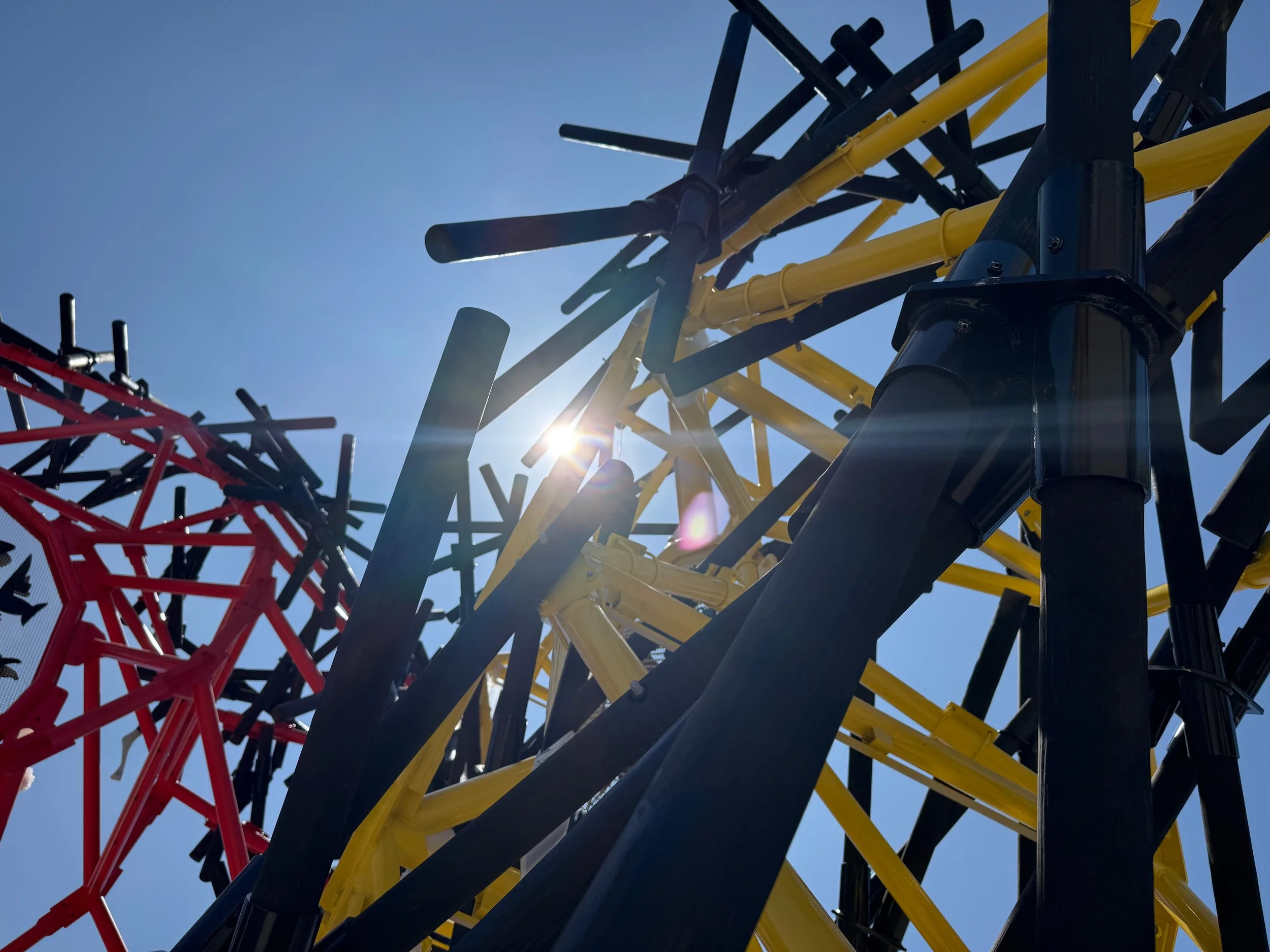Welcome to Under the Hood.
Let’s explore the creative ideas driving the studio
This Fall we have CROSSING on our minds. At a time rife with polarization, public art encourages us to intersect, collaborate, and commune. Hood Design Studio’s Walter Hood and Sarita Schreiber consider CROSSING as something physical and technical — and mythical and abstract.
PHOTOGRAPHY: JonnyArchives
“As an artist, public art allows me to move away from commemoration and memorialization, which can be a narrative pigeonhole, and move toward just expression. The work doesn’t always have to be heavy — it can be light, as in Migrations or The Nest .”
The Nest reflects the Charlotte’s resilience, unity, and evolution, serving as both a focal point and an invitation to connect.
PHOTOGRAPHY: Charlotte Business Journal
EXPRESSION MARK
WALTER HOOD, Founder + Creative Director
Being Southern, the word “crossing” immediately takes me to “crossroads.” These places where two or three things come together are places of importance with their own mythologies. The crossroad is where you go to meet the devil to get your mojo on. Or, particularly in the English landscape, it’s where people who were considered unholy by the church were buried, so that their restless spirits would confused and not haunt the living.
A crossing is something that is real and it’s also kind of an imaginary place that elides a fixed location. Similarly, our public art projects shift between figural and abstract, between physical and conceptual.
The studio’s public art practice grew out of an interest in history and commemoration. It is challenging in architecture and landscape architecture to express a level of subjectivity that’s not immediately pedagogically explained. We found in our art installations that through making, material, and fabrication we could achieve a different sensibility and a different way to say something in public that doesn’t rely on the language of landscape architecture.
McColl Park, where The Nest is located, is the highest elevation in downtown Charlotte, North Carolina. It’s where everything — trade, commerce — comes together. When I grew up there, Independence Square was a place where everybody met. The physicality of the space has an intensity, which was echoed in the place of art, buildings, and symbols on the ground. But I didn’t want to keep reinforcing the same thing. The Nest is a crossroads, but it’s also a metaphor for bringing things together. The installation is a tensegrity structure suspended over a pool of water and it comes from the idea that birds collect a variety of materials from different places to build a communal nest.
The Nest is an aerial installation that marks a crossing — the ground is only marked through water. It is ephemeral, animated with reflection, shadow, and light. We went to McColl Park one evening to celebrate the opening, all the representational statues and text on the ground seemed to disappear. The phenomenological aspects of the artwork levitating over the landscape won out.
PHOTOGRAPHY: Hood Design Studio
“We work at the intersection of crossings in terms of discipline, but also across time.”
Our community papel-picado banner workshop was centered around the theme of flight.
PHOTOGRAPHY: Hood Design Studio
As both landmark and metaphor, Migrations invites reflection on the intertwined journeys of species, cultures, and communities in constant motion.
PHOTOGRAPHY: Hood Design Studio
PUSHING BOUNDARIES
SARITA SCHREIBER, Associate + Art Practice Manager
The idea of crossing as an act of productive transgression is very important to the studio’s art practice. We like to blur the boundaries between art, landscape, and architecture, but it’s the temporal crossings: the layering of a site with its past history, its ecological context, that drive our landscape design and public art practice.
Much like the interwoven members of The Nest, the physicality of Migrations installation also evokes crossing. Located at the San Diego Airport, Migrations is made up of two abstracted bird heads — one is 40-feet tall and the other 20-feet tall. As in folklore, we use the metaphor of flight to talk about transgressing beyond present circumstance. The piece alludes in part to the US-Mexico border, drawing inspiration from the great bird migration flyaway and global mythologies where avian-human figure symbolize transformation, rebirth, and freedom.
Exterior public art at this scale defines place and creates memory. Standing bright red and yellow in graphic contrast to the new airport terminal, my hope is these sculptures serve as “provocations of place”, becoming a landmark over time. First-time visitors may find them unfamiliar and strange in their abstraction, but that’s what I love about public art, it forces people to find their own entry points, bringing their own sensitivities and readings to it based on its shape, title, and materials. The artwork becomes the crossroads for critical thought and interpretation.
There are also some very technical ways in which our latest installation relates to the theme of crossing. Migrations is composed of modular crosses of charred, shou sugi ban cedar dowels attached to the pinwheeling steel structure. They form and entropic linear composition, creating volume and energy within the birds. In the end, these bundles seem almost calligraphic.
We worked very closely with the fabricator, Ignition Arts, Tipping Structural, and the installer to maintain flexibility in the bundle connection design. We were beholden to three sets of requirements: structural spans and connections, constructability of 3-axis rotation in the shop, and the physical realities and tolerances of installing when you’re 40 feet in the air. Working with a repeated module counter to an ordered system is quite difficult, but by cultivating organic chaos we brought back the mess and humanized these large scale pieces of art.
Five kneeling figures emerge through granite walls within the outline of Gadsden’s Wharf storehouse.
PHOTOGRAPHY: Sahar Coston-Hardy
News
As part of The Kresge Foundation’s multi-million dollar investment in Detroit, Hood Design Studio will partner with the Marygrove Conservancy and develop a campus plan for the institution’s headquarters.
Walter spoke with Elle Decor and shared insight into the studio’s current projects, including the transformation of Lincoln Center Plaza and Damrosch Park.
Read the review of African Ancestors Garden in Landscape Architecture Magazine. Landscape historian Thaisa Way writes, “The garden interrogates, exhumes, remembers, navigates, and, ultimately, knows.”
Join Walter for “Cultural Storytelling Through Design” on November 4, hosted online by the New York Botanical Gardens. Register here.
Sarita Schreiber and fabricator Brian McCutcheon of Ignition Arts presented The Nest and Migrations at CODAsummit in Washington, DC. They discussed the challenges of modular design in public art practice.







